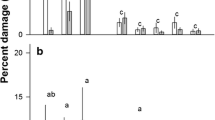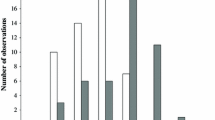Abstract
Salix sericea andS. eriocephala differ markedly in secondary chemistry.S. sericea produces phenolic glycosides, salicortin and 2′-cinnamoylsalicortin, and low concentrations of condensed tannin. In contrast,S. eriocephala produces no phenolic glycosides, but high concentrations of condensed tannins. Hybrid chemistry is intermediate for both types of chemicals, suggesting predominantly additive inheritance of these two defensive chemical systems from the parental species. However, there is extensive variation among hybrids. This variation may be due to genetic variation among parental genotypes, which genes were passed on, or to subsequent back-crossing. The differences in chemistry are likely to exert a strong effect on the relative susceptibility of hybrid and parental willows to herbivores.
Similar content being viewed by others
References
Aguilar, J.M., andBoecklen, W.J. 1992. Patterns of herbivory in theQuercus grisea × Quercus gambelii species complex.Oikos 64:498–504.
Argus, G.W. 1986. The genusSalix (Salicaceae) in the southeastern United States.Syst. Bot. Monogr. 9:1–170.
Barton, N.H., andHewitt, G.M. 1985. Analysis of hybrid zones.Annu. Rev. Ecol. System. 16:113–148.
Basey, J.M., Jenkins, S.H., andBusher, P.E. 1988. Optimal central-place foraging by beavers: Tree size selection in relation to defensive chemicals of quaking aspen.Oecologia 76:278–282.
Berenbaum, M.R., Zangerl, A.R., andNitao, J.K. 1986. Constraints on chemical coevolution: Wild parsnips and the parsnip webworm.Evolution 40:1215–1228.
Boecklen, W.J., andSpellenberg, R. 1990. Structure of herbivore communities in two oak (Quercus spp.) hybrid zones.Oecologia 85:92–100.
Bryant, J.P., Clausen, T.P., Reichardt, P.B., McCarthy, M.C., andWerner, R.A. 1987. Effect of nitrogen fertilization upon the secondary chemistry and nutritional value of quaking aspen (Populus tremuloides Michx.) leaves for the large aspen tortrix [Choristoneura conflictana (Walker)].Oecologia 73:513–517.
Clausen, T.P., Reichardt, P.B., Bryant, J.P., Werner, R.A., Post, K., andFrisby, K. 1989. Chemical model for short-term induction in quacking aspen (Populus tremuloides) foliage against herbivores.J. Chem. Ecol. 15:2335–2346.
Denno, R.F., Larsson, S., andOlmstead, K.L. 1990. Role of enemy-free space and plant quality in host-plant selection by willow beetles.Ecology 71:124–137.
Floate, K.D., andWhitman, T.G. 1993. The “hybrid bridge” hypothesis: Host shifting via plant hybrid swarms.Am. Nat. 141:651–662.
Fritz, R.S., Nichols-Orians, C.M., andBrunsfeld, S.J. 1994. Interspecific hybridization of plants and resistance to herbivores: Hypotheses, genetics, and variable responses in a diverse herbivore community.Oecologia 97:106–117.
Hagerman, A.E., andButler, L.G. 1989. Choosing appropriate methods and standards for assaying tannin.J. Chem. Ecol. 15:1795–1810.
Huesing, J., Jones, D., Deverna, J., Myers, J., Collins, G., Severson, R., andSisson, V. 1989. Biochemical investigations of antibiosis material in leaf exudate of wildNicotiana species and interspecific hybrids.J. Chem. Ecol. 15:1203–1217.
Julkunen-Tiitto, R. 1986. A chemotaxonomic survey of phenolics in leaves of northern Salicaceae species.Phytochemistry 25:663–667.
Julkunen-Tiitto, R. 1989. Phenolic constituents ofSalix: A chemotaxonomic survey of further Finnish species.Phytochemistry 28:2115–2125.
Julkunen-Tiitto, R., Tahvanainen, J., andSilvola, J. 1993. Increased CO2 and nutrient status changes affect phytomass and the production of plant defensive secondary chemicals inSalix myrsinifolia (Salisb.).Oecologia 95:495–498.
Kolehmainen, J., Roininen, H., Julkunen-Tiitto, R., andTahvanainen, J. 1994. Importance of phenolic glucosides in host selection of shoot galling sawfly,Euura amerinae, onSalix pentandra.J. Chem. Ecol. 20:2455–2466.
Levy, A., andMilo, J. 1991. Inheritance of morphological and chemical characters in interspecific hybrids betweenPapaver bracteatum andPapaver pseudo-orientale.Theor. Appl. Genet. 81:537–540.
Lindroth, R.L., andPeterson, S.S. 1988. Effects of plant phenols on performance of southern armyworm larvae.Oecologia 75:185–189.
Lindroth, R.L., Hsia, M.T.S., andScriber, J.M. 1987. Characterization of phenolic glycosides from quaking aspen.Biochem. Syst. Ecol. 15:677–680.
Lindroth, R.L., Scriber, J.M., andHsia, M.T.S. 1988. Chemical ecology of the tiger swallowtail: Mediation of host use by phenolic glycosides.Ecology 69:814–822.
Marquis, R.J. 1990. Genotypic variation in leaf damage inPiper arieianum (Piperaceae) by a multispecies assemblage of herbivores.Evolution 44:104–120.
Meier, B., Bettschart, A., Shao, Y., andLautenschlager, E. 1989. Einsatz der modernen HPLC fur chemotaxonomische Untersuchungen morphologisch schwer zu differenzierenderSalix-Hybriden.Planta Med. 55:213–214.
Nichols-Orians, C.M., Clausen, T.P., Fritz, R.S., Reichardt, P.B., andWu, J. 1992. A new phenolic glycoside isolated fromSalix sericea Marshall.Phytochemistry 31:2180–2181.
Nichols-Orians, C.M., Fritz, R.S., andClausen, T.P. 1993. The genetic basis for variation in the concentration of phenolic glycosides inSalix sericea: Clonal variation and sex-based differences.Biochem. Syst. Ecol. 21:535–542.
O'Donoughue, L.S., Raelson, J.V. andGrant, W.F. 1990. A morphological study of interspecific hybrids in the genusLotus (Fabaceae).Can. J. Bot. 68:803–812.
Orians, C.M. 1995. Preserving leaves for tannin and phenolic glycoside analyses: A comparison of methods using three willow taxa.J. Chem. Ecol. 21:1235–1243.
Paige, K.N., andCapman, W.C. 1993. The effects of host-plant genotype, hybridization, and environment on gall-aphid attack and survival in cottonwood: The importance of genetic studies and the utility of RFLPS.Evolution 47:36–45.
Price, P.W., Waring, G.L., Julkunen-Thtto, R., Tahvanainen, J., Mooney, H.A., andCraig, T.P. 1989. Carbon-nutrient balance hypothesis in within-species phytochemical variation ofSalix lasiolepis.J. Chem. Ecol. 15:1117–1131.
Rabotyagov, V.D. andAkimov, Y.A. 1987. Inheritance of essential oil content and composition in interspecific hybridization of lavender.Sov. Genet. 22:1163–1172.
Reiseberg, L.H., andBrunsfeld, S.J. 1992. Molecular evidence and plant introgression, pp. 151–176,in P.S. Soltis, D.E. Soltis, and J.D. Doyle (eds.). Molecular Systematics of Plants. Chapman and Hall, New York.
Rieseberg, L.H., andEllstrand, N.C. 1993. What can molecular and morphological markers tell us about plant hybridization.Crit. Rev. Plant Sci. 12:213–241.
Rowell-Rahier, M. 1984. The presence or absence of phenolglycosides inSalix (Salicaceae) leaves and the level of dietary specialization of some of their herbivorous insects.Oecologia 62:26–30.
Schultz, J.C. 1989. Tannin-insect interactions, pp. 417–433,in R.W. Hemingway and J.J. Karchesy (eds.). Chemistry and Significance of Condensed Tannins. Plenum Press, New York.
Tahvanainen, J., Julkunen-Thtto, R., andKettunen, J. 1985a. Phenolic glycosides govern the food selection pattern of willow feeding leaf beetles.Oecologia 67:52–56.
Tahvanainen, J., Helle, E., Julkunen-Thtto, R. andLavola, A. 1985b. Phenolic compounds of willow bark as deterrents against feeding by mountain hare.Oecologia 65:319–323.
Whitham, T.G. 1989. Plant hybrid zones as sinks for pests.Science 244:1490–1493.
Whitham, T.G., Morrow, P.A., andPotts, B.M. 1991. Conservation of hybrids.Science 254:779–780.
Whitham, T.G., Morrow, P.A., andPotts, B.M. 1994. Plant hybrid zones as centers of biodiversity: The herbivore community of two endemic Tasmanian eucalypts.Oecologia 97:481–490.
Zucker, W.V. 1983. Tannins: Does structure determine function? An ecological perspective.Am. Nat. 121:335–365.
Author information
Authors and Affiliations
Rights and permissions
About this article
Cite this article
Orians, C.M., Fritz, R.S. Secondary chemistry of hybrid and parental willows: Phenolic glycosides and condensed tannins inSalix sericea, S. eriocephala, and their hybrids. J Chem Ecol 21, 1245–1253 (1995). https://doi.org/10.1007/BF02027559
Received:
Accepted:
Issue Date:
DOI: https://doi.org/10.1007/BF02027559




